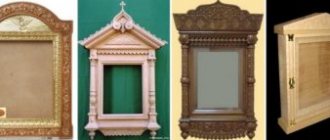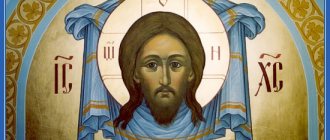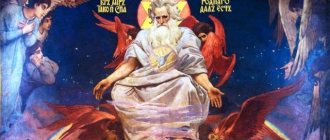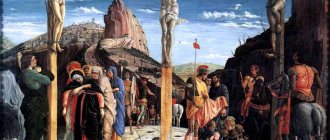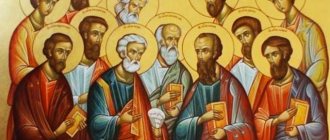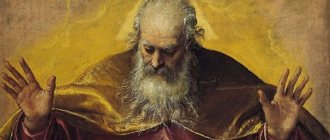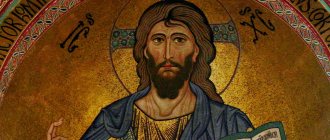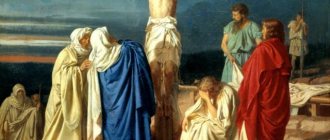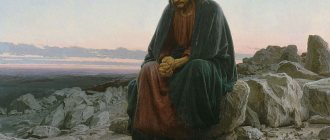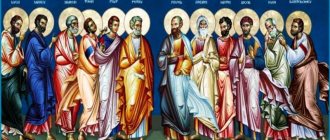- History of the icon of Jesus Christ: from antiquity to the present day
- The Savior Not Made by Hands
- Spas Pantocrator (Almighty)
- Savior on the Throne
- Savior in Strength
- Spas Emmanuel
- Spas Blagoye Silence
Veneration of icons is an important aspect of Christianity.
Decorated with images, the royal doors of the temple, frescoes on the walls of the church, relics in chapels and home collections of shrines - icons always accompany the believer, showing him the face of God, the Virgin Mary, revered martyrs and righteous people. They can be painted on boards, printed on paper, or even images poured out of amber, but the essence remains the same. However, in order to better understand the events shown, you still need to know what the characters represent, why they are drawn this way and not otherwise. And our article will help you with this! From it you will learn about the types of such relics, what features distinguish the image of the Savior Jesus Christ and how theologians interpret it.
The Savior Not Made by Hands
As the name suggests, the Miraculous Image of Jesus Christ was created not by human effort, but by the will of the Lord. There are different legends about how he appeared to people - according to one of them, the relic appeared on the scarf of the merciful woman Veronica, who wiped the face of the Savior as he carried the cross to Calvary. Others believe that the shrine was given to the king of Edessa, Abgar, who suffered from leprosy. The appearance of the icon also depends on this - in the Orthodox tradition, the face of the Savior is depicted as peaceful and calm, while among Catholics He looks suffering, stained with blood and crowned with thorns.
Photo and description of the Jesus icon
Holy images of the Most High Jesus Christ act as a mediator between the Heavenly Kingdom and earthly human light. Before the Image they offer prayers for the cure of serious ailments, pray for support in any grief, ask the Almighty to guide them on the true path and point out the correct solution to the fateful issue. Believers believe that if you say prayers in front of the icon of the Savior, then such a request will quickly reach the heavenly patron.
Dear Friends, we remind you that on our pages you can buy an icon of Stas Not Made by Hands, as well as buy icons of the Lord and buy icons of Jesus Christ and even buy an icon of the Last Supper!
Spas Pantocrator (Almighty)
In such icons, the Lord appears as a middle-aged man, with straight hair hanging down to his shoulders, a small mustache and a short beard. Jesus' right hand is placed on the Gospel, and his left is raised in a blessing gesture. The composition of the relics is different - they can show the Savior in full growth, waist-length, shoulder-length (like the “Ardent Eye of the Savior”, written in the XIV century) or sitting on the throne.
Similar frescoes or mosaics often decorate the domes and apses of temples. They give the cathedral vaults a resemblance to heaven, where Jesus retired and from where He must appear on the Day of the Last Judgment. The image has another interpretation - it shows believers the Son of God, who contemplates the Universe, participating in the fate of every person. An excellent example of such shrines is the painting “Christ Pantocrator” in the Vladimir Cathedral in Kyiv, created by V. M. Vasnetsov.
Iconography of Jesus Christ
/ > Iconography > Jesus Christ
The image of Jesus Christ is at the center of Christian fine art. The desire to comprehend and describe the Savior motivated the first masters who laid the foundations of Orthodox icon painting. This same desire caused considerable criticism from those church fathers who considered any depiction of God to be unacceptable paganism. The ideological conflict, which went down in history as the era of iconoclasm, dragged on for two centuries and ended with the full recognition of the position of the icon-worshipers, who argued that the honor given to the image goes to the prototype.
The iconography of Jesus Christ is filled with symbolism and is very diverse. The desire to present the image of God, incomprehensible in his highest essence, gave rise to various interpretations: Jesus the good shepherd and Judge, the Old Denmi and the youth Emmanuel, the king of the Jews and the Lamb.
Savior Not Made by Hands, Novgorod School, 12th century, Tretyakov Gallery
According to legend, the first icon of Christ was a miraculous image on a cloth (cloth), with which the Son of God wiped his face. The miraculous image healed the king of Osroene (Edessa) Abgar from leprosy and, subsequently, formed the basis for the extensive iconography of the “Savior Not Made by Hands.” The oldest icon that has survived to this day was painted in the 6th century using the encaustic technique (writing with wax paints) and is kept today in the Sinai monastery in Egypt.
A special trend in the iconography of Jesus Christ consists of allegorical images, which were especially popular in the early stages of the history of Christianity. The most famous among them are: the shepherd and the lamb. There are also images of Christ in the form of a pelican - a bird that, as was claimed in those days, feeds its chicks with its own flesh, which symbolizes sacrifice. The metaphorical image of a dolphin, which is often found in ancient paintings, represents a literal interpretation of the expression about “saving the drowning,” in the sense of saving drowning souls.
During the years of iconoclasm, symbolic images became widespread, as they made it possible to pay tribute to the Savior and avoid persecution. Subsequently, all allegories and metaphors were banned and, by the time of the schism of the church that occurred in 1050, the iconography of Jesus Christ turned out to be focused on his canonical image.
Savior Almighty. Board, wax paints, 6th century, monastery of St. Catherine, Egypt
Ideas about the appearance of the Son of God were based on legendary “lifetime” images and testimonies of “self-witnesses” - those who saw the Savior with their own eyes. These are believed to have included Pontius Pilate's predecessor, the proconsul of Judea Publius Lentulus, who described Christ in a letter to the Roman Senate. The text of the letter was discovered in the Middle Ages among the documents of the Archbishop of Canterbury and immediately raised a lot of doubts. One of the reasons is the enthusiastic style, unusual for the speech of a Roman governor. “This man is tall, important and has an appearance full of dignity, so that he inspires fear and love at the same time in those who look at him... This is the most beautiful of earthly creatures,” the author admires, betraying his Christian beliefs. A similar description is contained in the “Life of St. Andrew the First-Called,” compiled at the beginning of the 9th century by the Jerusalem monk Epiphanius. As for the early images of Christ, the theologian Irenaeus of Leonsky wrote in the 2nd century about a certain image that was allegedly made by Pilate himself.
By the time of the formation of Russian icon painting at the turn of the 11th - 12th centuries, the system of images of Christ was finally formed. At the center of the iconography were two main types - the Savior Not Made by Hands and Christ Pantocrator. The first type represents the face of Jesus Christ on a white or gold background and refers to the story of the legendary miracle made by King Abgar. The main meaning of the image is associated with the idea of the divine, miraculous beginning of icon painting as such.
Savior in strength from the Deesis rank of the Spaso-Preobrazhensky Monastery. Board, tempera, 16th century, Yaroslavl Historical, Architectural and Art Museum-Reserve
The image of Christ Pantocrator (Pantocrator) constitutes the central direction of the Christological cycle. This group includes such icons as “Savior on the Throne”, “Savior in Powers”, “Psychososter” (Soul Savior), “Eleemon” (Merciful) and some others. The iconography is based on the representation of Christ as the Heavenly King and Judge. The Savior is depicted standing tall, waist-deep, shoulder-length, or sitting on a throne. In his left hand there is a scroll or Gospel, his right hand is bent in a blessing gesture, and around his head there is a special cross-shaped halo, which is an obligatory element of the image of Christ, as well as the combination of blue and red colors of clothes and background.
In general, Orthodox icon painting knows more than ten characteristic directions in the iconography of Jesus Christ. Images of the Savior in adolescence belong to the type of Savior Emmanuel. The image of Old Denmi, on the contrary, represents Christ as a gray-haired old man. A special direction - “Passion Cycle” - combines images on the theme of the Passion, including such icons as “Crucifixion”, “Entombment”, “Do not cry for Me, Mother”, “Descent into Hell” and others. Some icons, such as the “Angel of Good Silence” and the “Angel of the Great Council,” represent Christ in the archangelic rank, that is, in the heavenly, divine essence, before incarnation in the human body.
Savior on the Throne
This iconographic type is in many ways similar to the previous one, but the Son of God is always shown in full growth, seated on a throne . The prototype of His appearance was the icon of Jesus Christ “Image Not Made by Hands,” but the symbolism of the throne developed later. This element is the embodiment of the whole world, signifying the royal glory of the Lord and the honor given to Him.
Most often, angels, saints and seraphim appear before the Savior, but sometimes figures of emperors, kings and archbishops are drawn before Him, expressing the idea of the sacred origin of their power. Such frescoes can be seen in the Constantinople Cathedral of St. Sofia and the Temple of Torcello (Italy, XII century).
What does the icon say?
When turning your gaze to the image of Christ, you must remember that the icon cannot contain God entirely. She is only an image, and only of an earthly incarnation. The divine essence cannot be comprehended by man. Just like an ant cannot fully comprehend the world around it, but only that part that it can perceive.
Descriptions of the appearance of the Savior are found among ancient historians, but in icons they are not followed verbatim, although the general features remain recognizable. In iconography, a tradition has developed to depict the Holy Face according to the rules of the golden ratio. The classic Russian version is Novgorod Spas. There are general rules:
- A halo in the shape of a cross - consists of 9 crossbars, according to the number of angelic ranks.
- Expressive eyes, their size is larger than usual.
- Greek letters, abbreviation of one of the names of God - Jehovah.
- Slavic abbreviation of the name Jesus Christ.
Additional elements can be a scarf(s), words of prayer, angels, saints.
Savior in Strength
The tradition of this relic arose in the XIV-XV centuries. based on the book of the prophet Ezekiel and the revelation of John the Theologian. Jesus seated on the throne is depicted against the background of a red square - a symbol of the earth and a blue circle - the celestial sphere, where ethereal forces and angelic ranks reign. The figure of the Lord is also surrounded by a scarlet halo, personifying His fiery nature and the revelation brought to people. Often icon painters add other details to the image, turning it into a real theological treatise.
The icon of A. Rublev, painted in 1408, belongs to this type. It allegorically shows the Earthly and Heavenly Church, and all believers are promised salvation in the Kingdom of Heaven.
Spas Blagoye Silence
This is a very rare type of icon. If, while reading the akathist to the image of our Lord Jesus Christ not made by hands, you look at His earthly appearance, then the Good Silence of the Savior reveals to Christians the appearance of the Lord before His coming to people . This is the only shrine where the Savior’s halo is crowned not with a cross, but with an eight-pointed star - a sign of the incomprehensibility of the Lord.
In such images, the Son of God appears as the Angel of the Great Council - a beautiful young man in a white robe, behind whose back drooping wings appear white.
But, no matter what relic of Jesus you choose for your iconostasis, it will in any case support you, encourage you and protect you from adversity! And our online store “Amber of Polesie” will help you purchase it - here you will find unique icons poured from amber and decorated with solid gems.
Rare icons of Christ
A very famous icon is located in the Cathedral of Christ the Savior, its author is Evgraf Sorokin, an outstanding Russian icon painter. His Savior is very recognizable - his long hair falls to his shoulders, his eyes are deep-set, and in their expression you can see deep sadness. Although in most churches they prefer to use more classical images of Byzantine writing.
Become a courier of the Yandex.Food service right now (up to 3,400 rubles per shift) leave a request →
In the iconography of Christ, there are joint icons of the Savior and the Mother of God. They talk about the most difficult moment - the burial of Christ. The Mother of God presses the body of her Son, already immersed in the coffin, to her, his eyes are closed, his hands are folded on his chest. The image recalls the day when the coming Resurrection was still ahead, and few believed in it. The composition is easily recognizable, although many details on it may change, even the position of Christ's body.
The image of “Christ in the tomb” is also very rare - the body of the Savior rests on a stone bed, as was customary for burial among the Jews. Jesus lies on his back, in white shrouds, and wounds may be depicted on his body (on his arms and rib). Such icons should remind us of the price by which the entire human race was redeemed.
